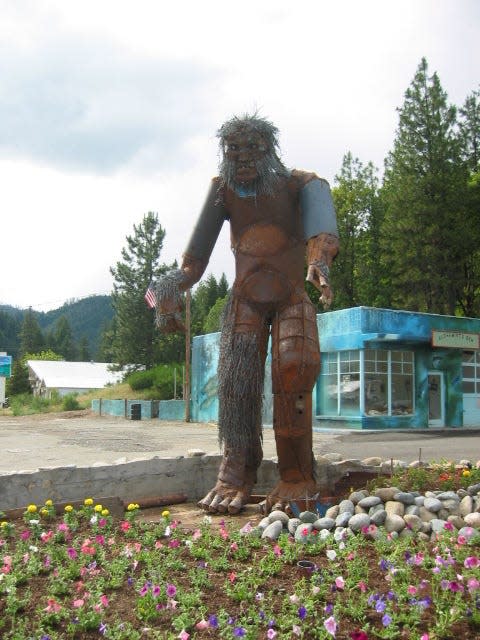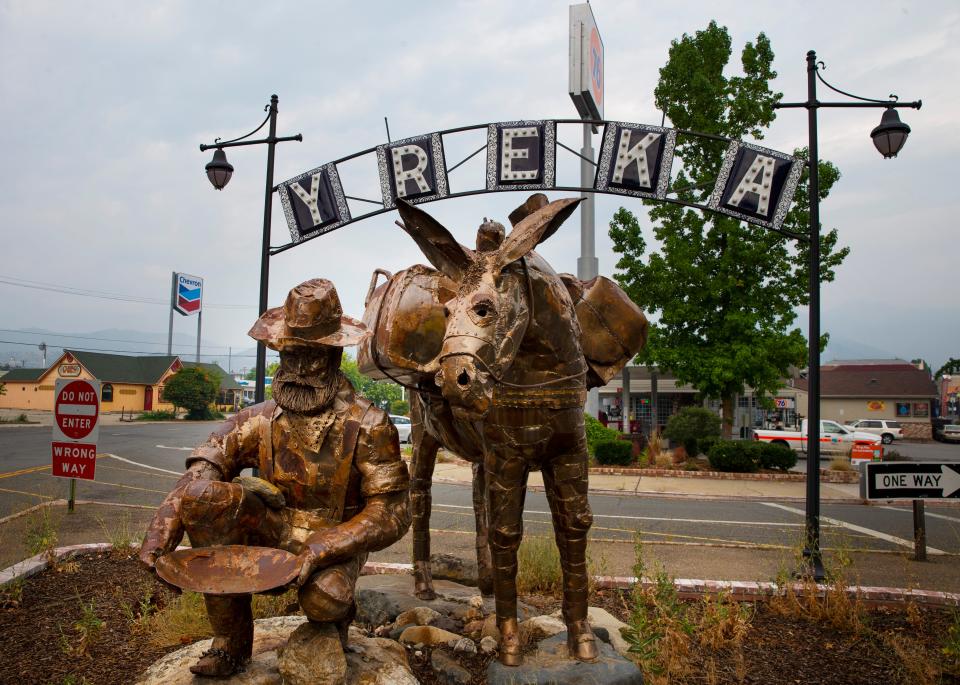Ever seen Bigfoot, cows or a dragon along Interstate 5? Here's the Yreka artist to thank.
You may never have heard the name Ralph Starritt, but if you've driven in far Northern California on Interstate 5, you know his work.
The giant metal cows that stand in a grassy space along the highway between Granada and Yreka are among dozens of Starritt's sculptures that dot the North State.
Truckers traveling on the highway told the artist it’s common practice to use the cows rather than town names to designate location, Starritt said.
“It’s always a good feeling” knowing his sculptures are North State landmarks that became an integral part of Siskiyou County culture, said Starritt.
Now the metal artist is finishing the first phase of a long-term project to create Native American themed sculptures from Hoopa to I-5, he said.
Starritt, now 79 years old, said he’s lost count of how many of his sculptures dot the North State, but he’s been creating public art installations since the early 1970s.
His mother and daughter bovine sculptures are probably the best known to motorists who travel the I-5 corridor. Built in 1995, truckers named the mother cow Moo-donna, Starritt said. He added the calf two years later. “Her name is Moona Lisa,” he said.
Starritt works out of his Yreka studio, shaping copper, brass, steel and occasionally aluminum. Sometimes he paints the scenes and sculptures he makes.
Most of his business is walk-in or telephone customers. He doesn’t have a website. “I’m not a computer jock,” he said.
His best advertisements are his work.
Starritt’s metal sculptures ― most of which are larger than the people, animals and objects he depicts ― grace towns throughout Northern California, including Yreka, Montague and Etna and in Oregon, Shady Cove and Jacksonville.
His scene of Lake Shasta, Shasta Dam and Mt. Shasta sits in Shasta Lake City Hall. He also sculpted two oxen that “greet” tourists and residents on Main Street in Yreka.
Note to readers: We hope you are enjoying this article. If you are able, please subscribe to the Redding Record Searchlight. Your support goes a long way in helping us bring you coverage with a twist you won't find anywhere else.
North of the cows on I-5 lurks Starritt’s dragon sculpture, Penelope.
This summer, Starritt began what he hopes will be a long-term project to celebrate and commemorate the North State’s Native American heritage. He’s working for the California Department of Transportation and the Hoopa Valley Tribe installing sculptures on posts along Highway 96 near the town of Hoopa in northeastern Humboldt County, said Starritt, whose paternal family is Karuk.
Scheduled for installation in early July, the first three sculptures are a 4-foot-wide basket, a 4-foot-tall jump dance headdress and 5-foot-tall feathers, he said.
Future plans include more Native American sculptures dotting the highway, 71 miles from Hoopa to Happy Camp, and possibly another 65 miles to I-5. "That will keep me busy for the next two years,” Starritt said.
How community and artist helped town turn trash into trademark
More than 20 years ago, the mythic hominid known as Bigfoot cast off his shy ways and took a gig greeting visitors in a small Siskiyou County town, east of Yreka.
Well, at least his statue did.
In 2001, Starritt helped Happy Camp resident Cheryl Wainwright and other community members create the 15.5-foot sculpture and install him ― standing in a flower bed ― at the Highway 96 and Davis Road intersection.

Happy Camp residents have known Bigfoot since he was nothing more than refuse.
Starritt and the people of Happy Camp used scrap metal gathered during a community cleanup to piece Bigfoot together, Wainwright said.
Now, 22 years later, the statue does “exactly what it was supposed to do,” Wainwright said: Bring the community together and create an iconic landmark for Happy Camp.
Miner yields golden opportunity
Starrett grew up in Siskiyou County, graduating from Yreka High School in 1962. He moved to Redding and earned his associate’s degree in art at Shasta College in 1965, then studied at the Academy of Art in San Francisco in the late 1960s, Starritt said.
While at Shasta College, he also studied mechanics, where he learned techniques that helped him with his later work in metals.
He moved back to Yreka and took a job at the Timber Products mill early in the 1970s, but still put his heart into his art, Starritt said.

He created his first permanent North State public art installation in July, 1976: A miner crouching to pan for gold with his mule behind him. The pair still grace the Yreka downtown exit to I-5, he said.
To see more of the artist's work visit Starritt Studio at 1557 S. Main St. in Yreka or call 530-905-2521.
Jessica Skropanic is a features reporter for the Record Searchlight/USA Today Network. She covers science, arts, social issues and news stories. Follow her on Twitter @RS_JSkropanic and on Facebook. Join Jessica in the Get Out! Nor Cal recreation Facebook group. To support and sustain this work, please subscribe today. Thank you.
This article originally appeared on Redding Record Searchlight: How Bigfoot, cows and a dragon ended up along Interstate 5

